History - Cholas | 11th History : Chapter 11 : Later Cholas and Pandyas
Chapter: 11th History : Chapter 11 : Later Cholas and Pandyas
Cholas
CHOLAS
Origin of the Dynasty
Records available to us after the Sangam Age show that the Cholas remained as subordinates to the Pallavas in the Kaveri region. The re-emergence of Cholas began with Vijayalaya (850–871 CE) conquering the Kaveri delta from Muttaraiyar. He built the city of Thanjavur and established the Chola kingdom in 850. Historians, therefore, refer to them as the Later Cholas or Imperial Cholas. In the copper plate documents of his successors that are available, the Cholas trace their ancestry to the Karikala, the most well-known of the Cholas of the Sangam age. In their genealogy an eponymous king ‘Chola’ is mentioned as the progenitor. The names of Killi, Koc-cengannan and Karikalan are mentioned as members of the line in these copper plates.
Vijayalaya’s illustrious successors starting from Parantaka I (907–955) to Kulothunga III (1163–1216) brought glory and fame to the Cholas. Parantaka Chola set the tone for expansion of the territory and broadened the base of its governance, and Rajaraja I (985–1014), the builder of the most beautiful Brihadishvarar temple at Thanjavur, and his son Rajendra I (1012–1044),whose naval operation extended as far as Sri Vijaya, consolidated the advances made by their predecessors and went on to establish Chola hegemony in peninsular India.
Sources
More than 10,000 inscriptions engraved on copper and stone form the primary sources for the study of Chola history. The inscriptions mainly record the endowments and donations to temples made by rulers and other individuals. Land transactions and taxes (both collections and exemptions) form an important part of their content. Later-day inscriptions make a mention of the differentiation in society, giving an account of the castes and sub-castes and thus providing us information on the social structure. Besides stone inscriptions, copper plates contain the royal orders.
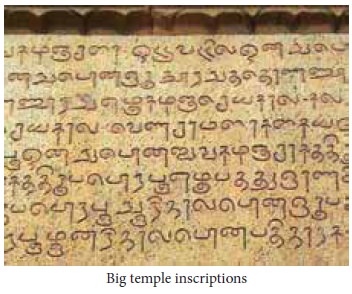
They also contain details of genealogy, wars, conquests, administrative divisions, local governance, land rights and various taxes levied. Literature also flourished under the Cholas. The important religious works in Tamil include codification of the Saivite and Vaishnavite canons. The quasi-historical literary works Kalingattupparani and Kulotungancholan Pillai Tamizh were composed during their reign. Muvarula, and Kamba Ramayanam, the great epic, belong to this period. Neminatam, Viracholiyam and Nannul are noted grammatical works. Pandikkovai and Takkayagapparani are other important literary works composed during this period.
Territory
Traditionally, the area under the Chola dynasty in the Tamizh country is known as Chonadu or Cholanadu. Their core kingdom was concentrated in the Kaveri-fed delta called Cholamandalam. This term came to be corrupted as “Coromandel” in the European languages, which often referred to the entire eastern coast of South India. The Chola kingdom expanded through military conquests to include present-day Pudukkottai– Ramanathapuram districts and the Kongu country of the present-day western Tamil Nadu.

By the 11th century, through invasions, Cholas extended their territory to Tondainadu or the northern portion of the Tamizh country, Pandinadu or the southern portions of the Tamizh country, Gangaivadi or portions of southern Karnataka and Malaimandalam, the Kerala territory. The Cholas ventured overseas conquering the north-eastern parts of Sri Lanka, bringing it under their control and they called it Mummudi-Cholamandalam.
1. Empire Building
Rajaraja I is the most celebrated of the Chola kings. He engaged in naval expeditions and emerged victorious in the West Coast, Sri Lanka and conquered the Maldives in the Indian Ocean. The military victory of Raja Raja I over Sri Lanka led to its northern and eastern portions coming under the direct control of the Chola authority. Rajaraja I appointed a Tamil chief to govern the annexed regions and ordered a temple to be built. It is locally called Siva Devale (shrine of Siva). The Chola official appointed in Sri Lanka built a temple in a place called Mahatitta. The temple is called Rajarajesvara.
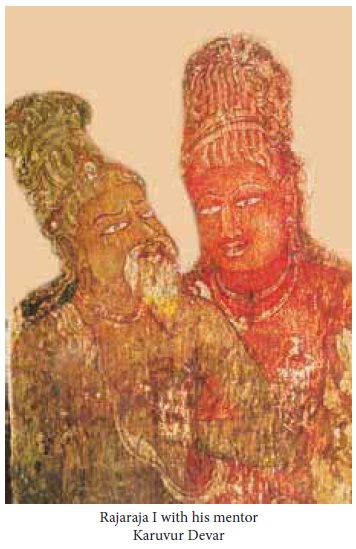
Even as he was alive, Rajaraja I appointed his son, Rajendra I, as his heir apparent. For two years, they jointly ruled the Chola kingdom. Rajendra I took part in the military campaigns of his father, attacking the Western Chalukyas. Consequently, the boundary of the Chola Empire extended up to Tungabhadra river. When Rajaraja I attacked Madurai, the Pandyas escaped with their crown and royal jewels and took shelter in Sri Lanka. Thereupon, Rajendra I conquered Sri Lanka and confiscated the Pandya crown and other royal belongings.
Rajendra I conducted the most striking military exploit after his accession in 1023 by his expedition to northern India. He led the expedition up to the Godavari river and asked his general to continue beyond that place. The Gangaikonda Chozhapuram temple was built to commemorate his victories in North India.
During the Chola reign, the naval achievements of the Tamils reached its peak. The Cholas controlled both the Coromandel and Malabar coasts. The Chola navy often ventured into Bay of Bengal for some decades. Rajendra’s naval operation was directed against Sri Vijaya. Sri Vijaya kingdom (southern Sumatra) was one of the prominent maritime and commercial states that flourished from c. 700 to c. 1300 in South-east Asia. Similarly, Kheda (Kadaram), feudatory kingdom under Sri Vijaya, was also conquered by Rajendra.
The Chola invasions of Western Chalukya Empire, undertaken in 1003 by Rajaraja I and 1009 by Rajendra I, were also successful. Rajendra sent his son to ransack and ravage its capital Kalayani. The dwarapala (door keeper) image he brought from Kalayani was installed at the Darasuram temple near Kumbhakonam, which can be seen even today. Rajendra I assumed the titles such as Mudikonda Cholan (the crowned Chola),Gangaikondan (conqueror of the Ganges), Kadaramkondan (conqueror of Kadaram) and Pandita Cholan (scholarly Cholan).
2. Chola Adminstration
King
Historians have debated the nature of the Chola state. Clearly, it was presided over by a hereditary monarchy. The king is presented in glowing terms in the literature and inscriptions of the period. Venerated on par with god. The kings were invariably addressed as peruman or perumagan (big man), ulagudaiyaperumal (the lord of the world) and ulagudaiyanayanar (the lord of the world). Later, they adopted the titles such as Chakkaravarti (emperor) and Tiribhuvana Chakkaravarti (emperor of three worlds). At the time of coronation, it was a practice to add the suffix deva to the name of the crowned kings. The kings drew legitimacy by claiming that they were a comrade of god (thambiran thozhar).
Chola rulers appointed Brahmins as spiritual preceptors or rajagurus (the kingdom’s guide). Rajaraja I and Rajendra I mention the names of rajagurus and Sarva-sivas in their inscriptions. Patronising Brahmins was seen to enhance their prestige and legitimacy. Chola kings therefore granted huge estates of land to Brahmins as brahmadeyams and caturvedimangalams (pronounced chatur-vedi-mangalam).
Provinces
As mentioned earlier, the territories of the Chola state had been expanding steadily even from the time of Vijayalaya. At the time of conquest, these areas were under the control of minor chiefs described by historians as “feudatories”. Rajaraja I integrated these territories and appointed “viceroys” in these regions: Chola-Pandya in Pandinadu, Chola-Lankeswara in Sri Lanka, which was renamed as Mummudi-cholamandalam, and Chola-Ganga in the Gangavadi region of southern Karnataka. In other less prominent regions, the territories of chiefs such as the Irukkuvels, Ilangovels or Mazhavas or Banas were made part of the Chola state and their chiefs were inducted into the state system as its functionaries.
Army
Cholas maintained a well-organised army. The army consisted of three conventional divisions: infantry, cavalry (kudirai sevagar) and the elephant corps (anaiyatkal). There were also bowmen (villaligal), sword-bearers (valilar) and spearmen (konduvar). Two type of ranks in the army are also mentioned: the upper and the lower (perundanam and cirudanam). According to a Chinese geographer of the 13th century, the Chola army owned “sixty thousand war elephants that, when fighting, carried on their backs houses, and these houses are full of soldiers who shoot arrows at long range, and fight with spears at close quarters”. The overseas exploits of the Cholas are well known and it led historians to refer to their navy “with numberless ships”. Generally, soldiers enjoyed padaipparru (military holding) rights. Cantonments, which were established in the capital city, were known as padaividu. Military outposts in the conquered territory were called nilaipadai. The captain of a regiment was known as nayagam and later he assumed the title of padaimudali. The commander-in-chief was senapati and dandanayagam.
Local Organisation
Various locality groups functioned actively in the Chola period. These were bodies such as Urar, Sabhaiyar, Nagarattar and Nattar. They were relatively autonomous organisations of the respective groups. They are considered the building blocks using which the edifice of the Chola state was built.
Urar
With the expansion of agriculture, numerous peasant settlements came up in the countryside. They were known as ur. The urar, who were landholders in the village, acted as spokesmen in the ur. The urar were entrusted with the upkeep of temples, maintenance of the tanks and managing the water stored in them. They also discharged administrative functions of the state such as collection of revenue, maintenance of law and order, and obeying the king’s orders.
Sabhaiyaar
If the ur was a settlement of land holders, largely consisting of peasants of vellanvagai, the brahmadeya was a Brahmin settlement. The Sabha looked after the affairs of the settlement, including those of the temples at the core of brahmadeya and its assets. It was also responsible for maintaining irrigation tanks attached to the temple lands. Like the ur, the Sabha also functioned as the agents of the state in carrying out administrative, fiscal and judicial functions.
Nagarattaar
Nagaram was a settlement of traders. However,skilledartisansengagedinmasonry, ironsmithing, goldsmithing, weaving and pottery also occupied the settlement. It was represented by the Nagarattaar, who regulated their association with temples, which needed their financial assistance. In the reign of Rajaraja I, Mamallapuram was administrated by a body called Maanagaram. Local goods were exchanged in nagarams. These goods included silk, porcelain, camphor, cloves, sandalwood and cardamom according to Chinese accounts. In order to promote trade, inland and sea way, Kulotunga revoked the collection of toll fee (sungam). Hence he was conferred the title Sungam Thavirtha Chozhan.
Nattar
Nadu was a grouping of several urs, excluding brahmadeyas formed around irrigation sources such as canals and tanks. Nattar (literally those belonging to the nadu) were the assembly of landholders of vellanvagai villages (urs) in nadu. Nattar functioned as pillars of the state structure under the Cholas. They discharged many of the administrative, fiscal and judicial responsibilities of the state. They held hereditary land rights and were responsible for remitting the tax from the respective nadu to the state. Landholders of the nadu held the honorific titles such as asudaiyan (possessor of land), araiyan (leader) and kilavan (headman). There were functionaries such as the naattukanakku and nattuviyavan, recording the proceedings of the Nattar.
3. Economy
Agriculture
One of the major developments in this period was the expansion of agriculture. People settled in fertile river valleys, and even in areas where there were no rivers, and arrangements were made for irrigation by digging tanks, wells and canals. This led to the production of food grain surplus. Society got differentiated in a big way. The Chola state collected land tax out of the agrarian surplus for its revenue. There was an elaborate “department of land revenue” known as puravuvari-tinaikkalam, with its chief called puravuvari-tinaikkalanayagam.
Land Revenue and Survey
For the purposes of assessing tax, the Cholas undertook extensive land surveys and revenue settlements. Rajaraja I (1001), Kulotunga I (1086) and Kulotunga III (1226) appointed people for land survey so that the land could be classified and assessed for the purposes of taxation.
Like other functionaries of the state, the surveyors of the land called naduvagaiseykira too hailed from the landholding communities. Various units of the land measurement such as kuli, ma, veli, patti, padagam, etc. are known, with local variations. Generally, taxes were collected in different forms. The taxes collected included irai, kanikadan, iraikattina-kanikadan and kadami. An important category of tax was kudimai. Kudimai was paid by the cultivating tenants to the government and to the landlords, the bearers of honorific titles such as udaiyan, araiyan and kilavar. The tax rates were fixed depending on the fertility of the soil and the status of the landholder. Opati were levied and collected by the king and local chiefs. Temples and Brahmins were exempted from paying the taxes. The tax paid in kind was referred to as iraikattina-nellu. All these were mostly realised from the Kavery delta but not widely in the outskirts of the kingdom. At the ur (village) level, urar (village assembly) were responsible for collecting the taxes and remitting them to the government. At the nadu level, the nattar were responsible for remitting taxes.
Irrigation
Cholas undertook measures to improve the irrigation system that was in practice. As the state was drawing most of its revenue from agriculture, the Cholas focused their efforts on managing water resources. Vativaykkal, a criss-cross channel, is a traditional way of harnessing rain water in the Kavery delta. Vati runs in the north–south direction while vaykkal runs in the east–west direction. Technically, vati is a drainage channel and a vaykkal is a supply channel. The water running through vaykkal to the field was to be drained out to vati and to another vaykkal. Rain water would flow from where the natural canal started. Many irrigation canals are modifications of such natural canals. The harnessed water was utilised alternately through vati and vaykkal. Here the mechanism designed was such that water was distributed to the parcelled out lands in sequel.
Many canals were named after the kings, queens and gods. Some examples of the names are Uttamachola-vaykkal, Panca-vanamadevi-vaykkal and Ganavathy-vaykkal. Ur-vaykkal was owned jointly by the landowners. The nadu level vaykkal was referred to as nattu-vaykkal. The turn system was practiced for distributing the water. Chola inscriptions list some big-size irrigation tanks such as Cholavaridhi, Kaliyaneri, Vairamegatataka created by the Pallavas, Bahur big tank and Rajendra Cholaperiyaeri. For the periodical or seasonal maintenance and repair of irrigation works, conscripted labour was used.
Water Management
Different kinds of water rights were assigned. These rights regulated the share of water from the tanks and wells; it also entailed the right of deepening and broadening the channels and repairing the irrigation system. The allotment of water is described as nirkkiintavaru (share of water as allotted).The water was released through kumizh (sluice) or talaivay (head-channel). Royal orders warned the people against the violation of water rights and encroachment of water resources gifted to the brahmadeya settlements. Commonly owned village tank was called enkalkulam (our tank). Land transaction in the form of donation and endowment were accompanied by water rights as well. For the periodical and seasonal maintenance and repair of the irrigation tanks, rendering free labour was in practice. Vetti and amanji were the forms of free labour related to public works at the village level.
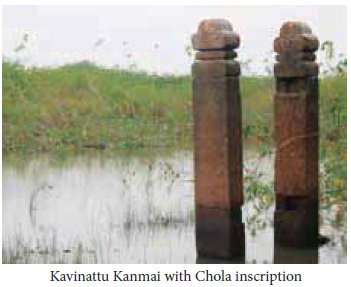
Village assemblies under the Cholas collected a tax called eriayam, which was utilised for repairing irrigation tanks. Sometimes local leaders like araiyan repaired and renovated irrigation tanks destroyed in a storm. There were instances of the water from a tank shared by villagers and the temples. Special groups known as talaivayar, talaivay-chanrar and eri-araiyarkal were in charge of releasing the water through the head channel and sluice from the rivers or tanks. A group of people who were in charge of kulam was called kulattar. In later period, temples were entrusted with the upkeep of the irrigation sources.
4. Society and its Structure
In the predominantly agrarian society prevailing during the Chola period, landholding was the prime determinant of social status and hierarchy. The Brahmin landholders called brahmadeya-kilavars at the top brahmadeya settlements with tax exemption were created, displacing (kudi neekki) the local peasants. Temples were gifted land known as devadana, which were exempted from tax, as in brahmadeyams. The temples became the hub of several activities during this period.
The landholders of vellanvagai villages were placed next in the social hierarchy. Ulukudi (tenants) could not own land but had to cultivate the lands of Brahmins and holders of vellanvagai villages. While landholders retained melvaram (major share in harvest), the ulukudi got kizh varam (lower share). Labourers (paniceymakkal) and slaves (adimaigal) stayed at the bottom of social hierarchy.
Outside the world of agrarian society were the armed men, artisans and traders. There are documents that make mention of cattle-keepers who apparently constituted a considerable section of the population. There certainly were tribals and forest-dwellers, about whom our knowledge is scanty.
Religion
Puranic Hinduism, represented by the worship of Siva, Vishnu and associated deities, had become popular by the time of the Cholas. A large number of temples dedicated to these deities were built. The temples were provided vast areas of land and a considerable section of population came under their influence.
Chola rulers were ardent Saivites. Parantaka I and Uttama Chola (907–970) made provisions and gifted the lands to promote religion. In a fresco painting in which Rajaraja I is portrayed with his wives worshiping Lord Siva in Thanjavur Brihadishvarar temple. One of the titles of Rajaraja I is Siva Pada Sekaran, i.e. one who clutches the foot of Lord Siva.
Siva was the preeminent god for the Cholas and he was represented in two forms. The iconic form of Siva was Lingodhbhava, and the Nataraja idol was the human form. A trace of the locations of temple centres in Kavery delta could provide us the map of an agrarian-political geography spatially and temporally. The repeated representation of Tripurantaka (the destroyer of three mythical cities of asura) form of Siva in sculpture and painting gave him a warrior aspect and helped in gaining legitimacy for the ruler.
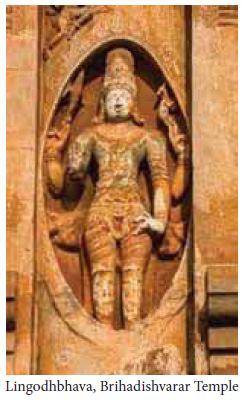
The representation of Nataraja or Adal Vallan (king of dance) in the form of idol was the motif of Tamil music, dance and drama with hymns composed by Nayanmars, the Saiva saints. These hymns sang the praise of Siva and extolled the deeds of god. They held great appeal to the devotees from different social sections.
The Saiva canon, the Thirumurai, was codified after it was recovered by Nambi Andar Nambi. Oduvars and Padikam Paduvars were appointed to sing in the temples to recite Thirumurai daily in the temple premises. The singers of hymns were known as vinnappamseivar. The players of percussion instruments also were appointed. Girls were dedicated for the service of god. Musicians and dance masters also were appointed to train them.
A highly evolved philosophical system called Saiva Siddhanta was founded during this period. The foundational text of this philosophy, Sivagnana Bodham, was composed by Meikandar. Fourteen texts, collectively called Saiva Siddhantha Sastram, form the core of this philosophy. In later times, many Saiva monasteries emerged and expounded this philosophy.
The devotion of Chola rulers to Saivism became a strong passion in due course of time. Kulothunga II, for instance, exhibited such a trait. The theological tussle was fierce between state religion, Saivism, and Vaishnavism so much so that Vaishnavism was sidelined to the extent of its apostle Sri Ramanujar leaving the Chola country for Melkote in Karnataka.
Builders of Temples
The Cholas built and patronised innumerable temples. The royal temples in Thanjavur, Gangaikonda Chozhapuram and Darasuram are the repositories of architecture, sculpture, paintings and iconography of the Chola arts.
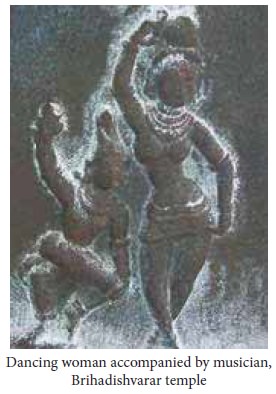
The temples became the hub of social, economic, cultural and political activities. The paraphernalia of the temples including temple officials, dancers, musicians, singers, players of musical instruments and their masers headed by the priests worshipping the gods reflect the royal court. In the initial stages, architecturally, the Chola temples are simple and modest. Sepulchral temples (pallip-padai) also were built where the kings were buried.
Temple as a Social Institution
Chola temples became the arena of social celebrations and functioned as social institutions. They became the hub of societal space in organising social, political, economic and cultural activities. The prime temple officials were koyirramar, koyilkanakku (temple accountant), deva-kanmi (agent of god), srivaisnavar, cantesar (temple manager) and others. They promoted the development of learning, dance, music, painting and drama. A play called Rajarajanatakam, based on the life of Rajaraja I, was performed in the Thanjavur temple. The festivals of Chithirai Tiruvizha, Kartigai and Aippasivizha were celebrated. It is said that singing hymns in temple premises promoted oral literacy. Traditional dance items like kudak-kuthu and sakkaik-kuthu were portrayed in the form of sculptures and paintings in the temples in Kilapalivur, Tiruvorriyur. Nirutya and karna poses are shown in sculptural forms in the Thanjavur big temple. Traditional Tamil musical instruments also were portrayed in this way.
The pastoral group, as a mark of devotion, donated livestock of specified number to the temples so as to maintain the perpetual lamp to be lit in the temple. To record their gift, their names were engraved in the inscriptions of royal temple. Thus, they earned royal affinity. The oil pressers called Sankarapadiyar supplied oil to the temple and became part of the functionaries of the temples. In times of famine, some of them sold themselves to the temple as servants.
Temples functioned as banks by advancing loans and by purchasing and receiving endowments and donations. They also became educational centres as training was imparted in Vedas, music and the arts. Sculpture and metal work too were promoted. Temple accounts were audited and the auditor was called koyilkanakku.
Gangaikonda Chozhapuram
In commemoration of his victory in North India, Rajendra I built Gangaikonda Chozhapuram on the model of Brihadisvarar temple in Thanjavur. He built an irrigation tank called Chola-gangamnearthecapitalcalledJala-stambha (water-pillar). It became the coronation centre, which was a Chola landmarks. The sculptures of Ardhanariswarar, Durga, Vishnu, Surya, Cantesa Anugrahamurty are the best pieces of the idols of gods placed in the niches of the outer wall of sanctum.
Darasuram Temple
Darasuram Temple, built by Rajaraja II (1146–1172), is yet another important contribution of the Cholas to temple architecture. Incidents from the Periyapuranam, in the form of miniatures, are depicted on the base of the garbha-griha (sanctum sanctorum) wall of the temple.
Trade
Increased production in agriculture as well as artisanal activities led to trade and growing exchange of goods for goods. This trade activity involved the notions of price, profit and market, which were not known in South India in the earlier period. Two guild-like groups are known: anjuvannattar and manigramattar. Anjuvannattar comprised West Asians, including Jews, Christians and Muslims. They were maritime traders and were settled all along the port towns of the west coast. It is said that manigramattar were busy with trade in the hinterland. They settled in interior towns like Kodumbalur, Uraiyur, Kovilpatti, Piranmalai and others. In due course, both groups merged and got incorporated under the banner of ainutruvar, disai-ayirattu-ainutruvar and valanciyar functioning through the head guild in Ayyavole in Karnataka. This ainutruvar guild controlled the maritime trade covering South-east Asian countries.
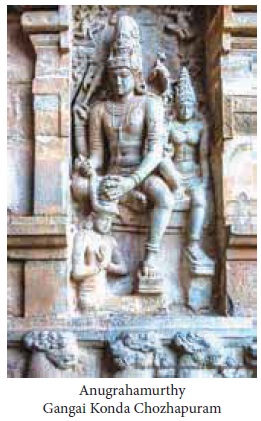
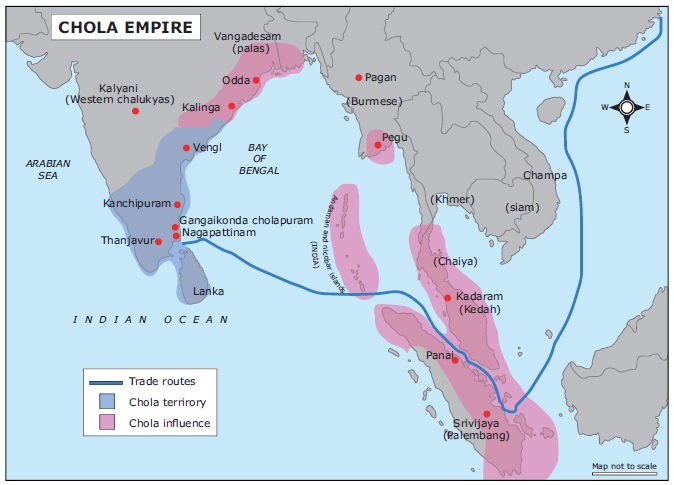
Munai-santai (Pudukkottai), Mylapore and Tiruvotriyur (Chennai), Nagapattinam, Vishakapattinam and Krishnapattinam (south Nellore) became the centres of the maritime trade groups. In the interior, goods were carried on pack animals and boat. The items exported from the Chola land were sandalwood, ebony, condiments, precious gems, pepper, oil, paddy, grains and salt. Imports included camphor, copper, tin, mercury and etc. Traders also took interest in irrigation affairs. Valanciyar, a group of traders, once dug an irrigation tank called ainutruvapperari in Pudukottai.
5. Cholas as Patrons of Learning
Chola kings were great patrons of learning who lavished support on Sanskrit education by instituting charities. From the inscriptions, we see that literacy skills were widespread. The great literary works Kamba Ramayanam and Periyapuranam belong to this period. Rajendra I established a Vedic college at Ennayiram (South Arcot district). There were 340 students in this Vaishnava centre, learning the Vedas, Grammar and Vedanta under 14 teachers. This example was later followed by his successors and, as a result, two more such colleges were founded, at Tribuvani near Pondicherry in 1048 and the other at Tirumukudal, Chengalpattu district, in 1067. In Sanskrit centres, subjects like Vedas, Sanskrit grammar, religion and philosophies were taught. Remuneration was given to teachers in land as service tenure.
The End of Chola Rule
The Chola dynasty was paramount in South India from the ninth to the thirteenth centuries. By the end of the twelfth century, local chiefs began to grow in prominence, which weakened the centre. With frequent invasions of Pandyas, the once mighty empire, was reduced to the status of a dependent on the far stronger Hoysalas. In 1264, the Pandyan ruler, Jatavarman Sundara Pandyan I, sacked the Chola’s capital of Gangaikonda Chozhapuram. With Kanchipuram lost earlier to the Telugu Cholas, the remaining Chola territories passed into the hands of the Pandyan king. 1279 marks the end of Chola dynasty when King Maravarman Kulasekara Pandyan I defeated the last king Rajendra Chola III and established the rule by Pandyas.
Related Topics